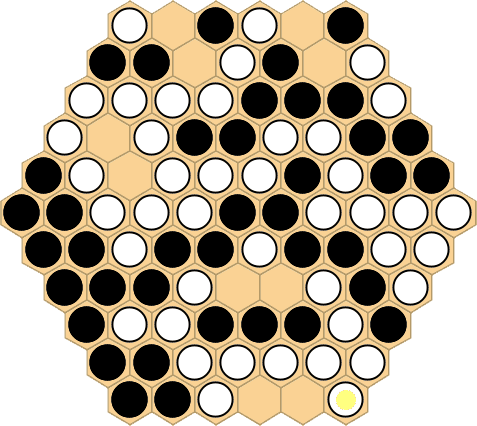|
Advertisement
|
Lifeline

DescriptionLifeline is a territorial strategy game for two players (Black and White) that is played on the cells of an initially empty hexhex board. The recommended board sizes are between 3 and 12 cells per side. The game was invented by Michael Amundsen and Luis Bolaños Mures. Although inspired by Go, it bears a significant resemblance to Kanare Kato's Meridians. DefinitionsA group is an entire set of connected stones of the same color. A single stone, not connected to others of its color, is also a group. A group is dead if there is no path of connected empty cells between that group and any other group of its color. The path does not need to be a straight line. PlayBlack plays first, then turns alternate. On your turn, perform the following actions in order:
The board positions at the start and at the end of your turn must be different. In other words, if the only stone you remove is the one you just placed, your placement is illegal. The last player to make a placement wins. Note that, after your first turn, you will always have a placement available unless you have no groups on the board. To make the game fair, White will have the option, on their first turn only, to swap sides with Black instead of making a regular move. VariantsThe standard game is made fair by the combination of the double first move and White's swap option, as described above. This balancing method is called strong pie. Some alternatives are:
Unlike strong pie, these methods require somewhat large boards to be effective: at least base 6 for weak pie, and at least base 7 for komi pie. —description from the designers Game DiscussionsAdd CommentYou need to be logged in to comment. Insert Bullet List Please enter at least one item. Item: Item: Item: Item: Item: Insert Numeric List Please enter at least one item. Item: Item: Item: Item: Item: Insert Link Please enter the link of the website Optionally you can add display text Insert Email Please enter the email address Optionally add any display text Insert Image Please enter the link of the image Insert YouTube Video Please enter the link of the video Marketplace | ||||

Comments (0)